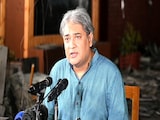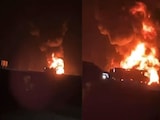- Volodymyr Zelensky faces pressure to accept a deal ceding territory for security guarantees
- Zelensky visits Washington with European leaders to seek clarity on US security guarantees
- Trump appears open to Putin's demands including Ukraine ceding eastern territories
Volodymyr Zelensky finds himself in an impossible bind: risk Donald Trump's wrath or accept a quick deal to end Russia's war in Ukraine by paying the disastrous price of ceding territory for vague security guarantees that could see Moscow come back stronger in a few years' time.
This is the existential dilemma confronting the Ukrainian leader as he travels to Washington for talks with the US president on Monday. Fresh off a summit in Alaska with Vladimir Putin that bypassed a ceasefire, Trump has left Zelensky little room to maneuver.
The situation is made even more tenuous by the memory of his last visit to the White House in February that erupted into a bitter exchange between Zelensky and Trump and briefly led to a halt in military support. This time a coterie of European leaders will accompany him, but they have questionable leverage and haven't always been on the same page.
The entourage will seek clarity from Trump on exactly what security guarantees the US is willing to provide as it attempts to orchestrate a meeting with the Ukrainian president and Putin. Among the group accompanying Zelensky are people Trump has struck a strong personal rapport with, including NATO Secretary General Mark Rutte and Finnish President Alexander Stubb.
Aside from avoiding another dispute and maintaining Trump's interest in brokering a deal, Zelensky's objectives in the talks include: learning more about Putin's demands, pinning down the timing for a trilateral meeting, and prodding the US toward tougher sanctions against Russia, according to a person familiar with the matter, who asked not to be identified discussing private deliberations.
Whether he can achieve any of these goals will depend on how much, in the view of European officials, Putin has gotten into Trump's head. After Friday's summit, Trump appeared to align again with the Russian president by dropping demands for an immediate ceasefire as a condition for opening negotiations. Instead, he said he'll urge Zelensky to act fast on a peace plan.
“Putin has many demands,” Zelensky said Sunday at a joint press conference with European Commission President Ursula von der Leyen in Brussels, a stopover to prepare for the Washington visit. “It will take time to go through them all — it's impossible to do this under the pressure of weapons,” he said, adding that a ceasefire would be needed to “work quickly on a final deal.”
Raising the stakes for Kyiv, the US president sounded open to Putin's demands that Ukraine give up large areas of land in the east of the country, which the Russian army and its proxies have been trying to seize since 2014.
Despite the harsh demands on Ukraine, there are signs that the US is now prepared to back a deal. Following his meeting with Putin, Trump told European leaders that the US could contribute to any security guarantees and that Putin was prepared to accept that. But it remains unclear what kind of security guarantees are being discussed with Putin, and what the Kremlin leader is willing to accept.
“We got to an agreement that the US and other nations could effectively offer Article 5-like language to Ukraine,” Steve Witkoff, Trump's special envoy, said in an interview with CNN, referring to the NATO provision that says if one ally is attacked, it is considered an attack on all members.
Trump is also under pressure. He had promised that after taking office in January he would quickly end Russia's full-scale invasion, which is in its fourth year. His efforts were mainly targeted at Kyiv but he ultimately had to acknowledge it was the Kremlin that didn't want to stop the war.
Instead of yielding to Trump, Russia has intensified attacks. Civilian deaths have mounted, with June and July the deadliest months in more than three years, according to the United Nations.
Ahead of the Alaska summit, Trump said refusal to accept a ceasefire would trigger tough new punitive measures on Moscow and countries buying Russian oil. After the meeting, which included a red-carpet reception for Putin and a shared ride in the US leader's armored limo, Trump called off the threats.
Rather than punish the aggressor, he declared he's seeking a full peace deal that includes “lands' swap” and urged Zelensky to accept it. On Sunday, the Ukrainian leader reaffirmed his stance that he won't give up territory or trade land.
“Since the territorial issue is so important, it should be discussed only by the leaders of Ukraine and Russia” at a meeting accompanied by the US, Zelensky said. “So far Russia gives no sign the trilateral will happen.”
Zelensky's refusal to accept territorial losses is a position shared by the majority of Ukrainians. But the level of support has softened as counteroffensives sputter and casualties mount. Still, fears are that a further retreat could invite later attacks.
Talks in Washington will also be pivotal for Zelensky domestically. In late July, he faced his first political crisis since Russia invaded. Thousands took to the streets over his move to undermine anti-corruption institutions. Zelensky relented and re-installed independence to agencies that investigate top officials.
His position in the talks is complicated by divisions among the US, Ukraine and other allies. Trump believes Russia can take the whole of Ukraine — although the Kremlin has managed only to seize less than a fifth of Ukraine's territory despite more than 1 million war casualties. Europeans, meanwhile, are wary that favorable conditions could encourage Putin to widen his aggression.
“It is important that America agrees to work with Europe to provide security guarantees for Ukraine,” Zelensky said on Sunday. “But there are no details how it'll work and what America's role will be, what Europe's role will be, what the EU can do. And this is our main task.”















